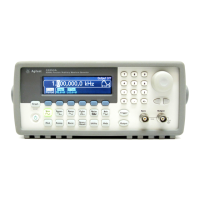115
Chapter 5 Theory of Operation
Timebase
4
5
Timebase
See “A1 Timebase Schematic” on page 192.
The Timebase provides a 10 MHz clock from which all the waveform
generation timing signals are ultimately derived. This clock can have one
of two sources: the internal crystal oscillator (U803) or an External BNC
input connector.
U803’s frequency is controlled by the System DAC signal, V_TBCAL.
When an external timebase is used, EXT_TB_EN is asserted, turning
Q801 and U803 off. EXT_TB_EN also turns Q802 on, grounding U803’s
control voltage input. U804-buffers U803’s output and inverts it so when
U803 is off, U804-D’s output is high.
The external input is isolated by T801 and applied to comparator U802.
U802 has two complementary outputs. One output is enabled by
EXT_TB_EN. The other output drives a charge pump circuit made up of
C809, CR801, C811, and R808. The voltage on C811 builds up when an
external signal is present and asserts EXT_TB_DET to inform the main
controller to use the external input (and assert EXT_TB_EN).
The outputs of the two timebase sources are ORed by U804-A and
become the FREF and PRI_FREF reference signals used by various parts
of the instrument. U804-B buffers FREF, then drives it out the “10 MHz
Out” BNC, J802.
The +16 V supply is filtered then regulated to a clean +5 V by U801 for
use by the frequency reference circuits.

